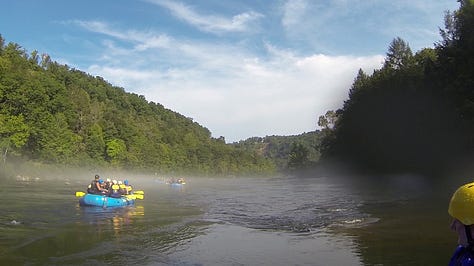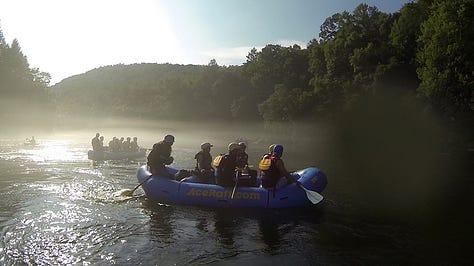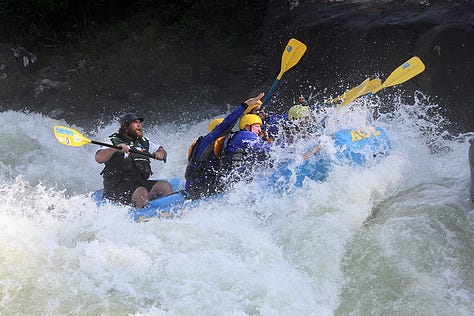GAULEY SEASON
…continued from Weekend 3: Bikerafting the Shenandoah
My last weekend in Appalachia was an all out balls to the walls whitewater shitstorm. I rafted West Virginia’s world famous Gauley River, a wild run of Class V rapids back to back, and got everything you could want out of a whitewater rafting trip. Huge wave trains, big ledges, powerful crashing torrents. The Gauley has it all.
Dropping 668ft at an average of 28ft per mile, it runs on a high gradient for 28 miles between the Summersville Dam and its confluence with the New River downstream. In the summer, levels and difficulty can vary, but all of that changes in the fall. Starting every weekend after Labor Day, the Army Corps of Engineers releases the Summersville Dam at a controlled flow of 2,400cfs for six consecutive weekends. The result is a huge series of torrents that cascade voilently through more than 100 rapids between the dam and the confluence below, drawing rafters and kayakers from all over the world.
I discovered it when I was planning my return to the New River Gorge. Commercial outfitters in the area shuttle rafters to both the New and Gauley Rivers, and though the New River is the bigger and more scenic of the two, the Gauley exceeds it sheer technical bone-crushing power. If it were a metal album, it would be the Heartwork-era Carcass of rivers.
There are five Class V rapids on the Upper Gauley, and they have plenty of III-IV rapids between them. Boulders and undercuts can often be seen along the riverbanks, necessitating scouting if you don’t have a guide with you. Its rapids – though iconic and well-known – are not for beginners or for the careless. I knew that guided commercial rafting was the only remotely safe way I could get through them, seeing as my kayak roll still pretty much sucks and I sure as hell wouldn’t try it in my packraft.



I drove out to Ace Raft on the first Friday evening of the season, slept in my parents’ van, and went down early on Saturday morning to the main building to check in. They had us sign release waivers, taught us basic whitewater safety, got us our paddling gear, and boarded us into a Gauley-bound school bus. We reached the put-in at Summersville Dam an hour later, where they organized us into different rafts. I was placed in a group with three other guys and a guide named Bear, a large bearded fellow and experienced riverman. I walked over and greeted him.
We got in the river, which at the onset was pretty cold (wise of me to rent a wetsuit at the lodge), and hit some good III-IV rapids early on as the fear and energy escalated. There were about thirty minutes worth of choppy waves and small holes to contend with as a warmup to Insignificant Rapid, the first Class V of the day. We needed all the time we could get to learn or perhaps relearn the paddling maneuvers needed to navigate this stuff. Fog lay heavily on the river and the roar ahead reminded us increasingly that the flatwater just above Insignificant was deceptively calm.
Soon enough, we were pounding through it. It is more or less a huge wave train with a lot of lateral waves and ledges that descend to the pool below. At the onset, its waves are small and manageable, but become increasingly bigger before passing a huge slanted boulder on the right and pouring into a big hole at the bottom. We rolled right through it and cheered in the flatwater.
It was big, but Pillow Rock was bigger. After thirty minutes or so of negligible, smaller rapids, we floated around a bend to the left and into earshot of what was easily the most dramatic and terrifying rapid of the day. In this section, the river channels into a huge crashing torrent that piles into Pillow Rock, a giant house sized boulder on river left. I knew all about it and remembered it well from my nightmares. My arms and legs were ice cold from adrenaline. Holy fucking shit. This is it!
Sunlight glimmered through the morning fog, and Bear steered us right through the middle of the golden, crashing water. We went right for it as turbulent water tumbled all around us, and Bear shouted “Touch the rock!” We smacked it with our paddles before dropping down another hole and washing out of the rapid. We cheered like we were the kings of the river and high fived our paddles.









Just downstream from Pillow, Hungry Mother Hole was ready to chew us up and spit us out of her huge, foaming jaws. Bear had us ferry in from the left and try to surf the hole. It didn’t work out. The left side of the raft got caught under the current, sending all of us except Bear into the water. In the camera boater’s footage, I can be seen tumbling out and flipping over as my body hit the side of the raft. I came up underneath for a second and kicked my way back to the side. Bear helped two guys back in while I scrambled back into the raft and helped the last guy in from the right.
We continued onto Lost Paddle, the longest Class V section of the river. It has four drops and is loaded with undercut rocks on both sides for most of the way. But nothing that can’t be avoided, as it mostly channels on a center line. We hit the first three drops without any trouble, including the 9ft drop at Hawaii 5-0 Wave, before eddying out to river right and catching our breath. We had one more drop, Tumblehome, the last and most nervewracking section of the rapid. True to its name, it threw us out of our seats, though we all stayed in the boat. Bear yelled at us to keep paddling as we tried to scramble back into position.
Iron Ring was next, a short and sweet little powerhouse of a Class V. It has two 8ft drops, which at dam season levels amount to a huge, beautiful wave train. We hit it head on.
There was one more Class V rapid left. The horizon line slowly vanished ahead as we approached the roar of Sweet’s Falls, the last of the “Big Five” of the Upper Gauley. It is a 14ft waterfall with a small flume right in the middle, giving boaters a smooth line through if they get it just right. A few feet too far right or left will surely mean a dramatic wipeout. Bear steered us smoothly in from the right and we got it by the throat. We hit a small hydraulic at the bottom and back-ferried past the boulders on river left.









Up ahead, we saw an injured kayaker in the water. The camera boater from one of the other outfitters had dislocated his shoulder going over the falls. We paddled up to him, Bear carefully got him into the raft, and we ferried him to shore. Somebody downstream recovered his kayak and he was safely evacuated. All was well again on the river, but it reminded me that you can never be too careful out there. Not even when you know what you’re doing. Bear tied down our raft and we went up to the tents along the banks for a grilled lunch.
Rafting outfitters stop all along the shores of Sweet’s Falls to eat lunch and watch the boaters go over the waterfall. We ate burgers and traded stories with the other groups about where we fell out, which at this point almost everybody had done somewhere.
I came back from the outhouse and saw a raft go over the falls and flip at the bottom, making for some disastrously awesome river carnage. The left side of the raft turned upward from a hydraulic, sending one guy sailing a few feet into the air. The other paddlers tumbled to the right, and half of this newly jettisoned dude landed on the capsizing raft before he tumbled into raging water. Everybody else fell out the other side. People on both riverbanks cheered like they just saw their favorite UFC fighter kick somebody into another timezone. The first thought that came to my mind was HOLY FUCK!!!!! They washed out into calming flatwater and recovered downstream.
After lunch, we got back in and paddled another few miles to the takeout at Wood’s Ferry. Most of the rapids were tamer and more spread out, giving me time to relax and ponder what it all fucking means. By the end of the day, I was certain that my balls had increased in size by at least twenty percent.
It is no exaggeration to say that the Upper Gauley River is the whitewater trip of a lifetime. But as is the case with any big river, you have to know what you’re doing. If you go, I recommend that you do at least one trip on another IV-V as practice, like the Lower New or Lower Gauley rivers. Both of those runs are tamer and more forgiving to swimmers. You should definitely know all of the commonly used paddling maneuvers and absolutely know what to do when you fall out. All that said, it is so worth it.
Bring your game face to this badass river, and take on the finest rapids in Appalachia.



